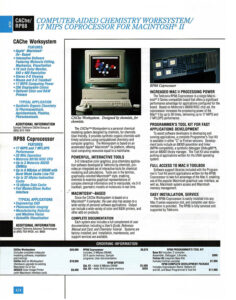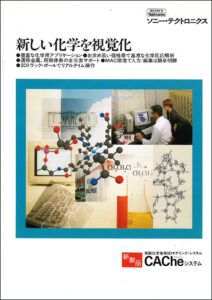Dave Friedley replaced Earl Wantland as President and CEO of Tektronix on October 23, 1987. He flattened the organizational structure and spun off many of the company vertically integrated component groups and began focusing on growth.
The Imaging Research Group in Tek Labs, headed up by George Fabel, had developed the liquid crystal color shutter. This shutter was first used to provide frame sequential color on Tektronix monochrome displays but work had progressed on also using it for stereo displays (Tektronix first foray into stereo display was on the Transmission Electron Microscope in 1968). George was looking for a clear market winner for stereo and settled on chemical modeling. They put together a demonstration using software originally developed at the University of Florida for displaying molecules to investigate more about the stereo display market and opportunity.
As they demonstrated this system, they found real interest in a computer aided chemistry worksystem for the design and interactive viewing of molecules. Looking for new areas of growth, this effort was spun out of Tek Labs in 1988 and became the CAChe Group headed up by George Fabel. His team included Ric DeHoff from Tek Labs (Hardware Engineering), George Purvis from University of Florida (Chemistry Software Development), Dave Gallagher from Tek UK (Sales and Marketing), and Linda Hirschy from the Printer Division (Marketing). Professors Jim Curry from Pacific University, Oregon, and Nigel Richards from University of Southampton, UK, consulted for the project. The group was located on the second floor above the kiln in Building 13, now the current home of the vintageTEK museum.
The resulting CAChe Worksystem, introduced in 1989, was a computer-aided design tool (CAD) developed by Tektronix for research chemists. It enables chemists to design new drugs or materials and predict their properties on the computer in a fraction of the time it would take to synthesize the molecules and test them in the lab. The 3D stereoscopic display enabled chemists to see the true shape of the molecules that they designed, which can be crucial to understanding their properties. Hence, it can help speed up chemistry research and development.
It was sold world-wide to research and development chemists and biochemists in pharmaceutical and chemical companies as a complete package (HW and SW) for about $50,000. It was sold also to universities for both research and teaching.
The original CAChe Worksystem was based around a Macintosh IIfx computer because of its easy-to-use graphical user interface. However, as the Macintosh was too slow for the required computations, a fast Motorola 68,000 RISC-based coprocessor card developed by Tektronix was plugged into the Macintosh NUBus slot to run all the software. In addition, a special Tektronix graphics card was used to drive the color monitor with a Tektronix 3D liquid crystal stereo shutter so that the shape of the molecules could be viewed and studied in all three dimensions.
The system embodies several Tektronix patents and inventions including:
- 3D stereoscopic liquid crystal shutter (for the monitor)
- 3D trackball to manipulate objects on the screen in 3D
- 3D screen cursor (software) to facilitate building 3D structures
- Motorola 68,000 RISC coprocessor card for NUBus slot
- 3D stereoscopic graphics card for NUBus slot
This 1990 catalog page describes the CAChe Worksystem. Click on the image to view the PDF.
By 1991 this group was spun out of Tektronix and became a wholly-owned subsidiary named CAChe Scientific Inc. In 1994 CAChe Scientific Inc. was sold to Oxford Molecular Group PLC. In 2000 the CAChe business was sold to Fujitsu, who eventually discontinued the product line in 2009.
The museum has a working CAChe WorkSystem on display and the 3D glasses to view the image. Without the glasses, you can see the dual image in this photo.

Sony/Tek also sold the CAChe system. Click on the image to view the PDF (in Japanese).
This 1992 brochure is from the CAChe Scientific subsidiary. Click on the image to view the PDF.



